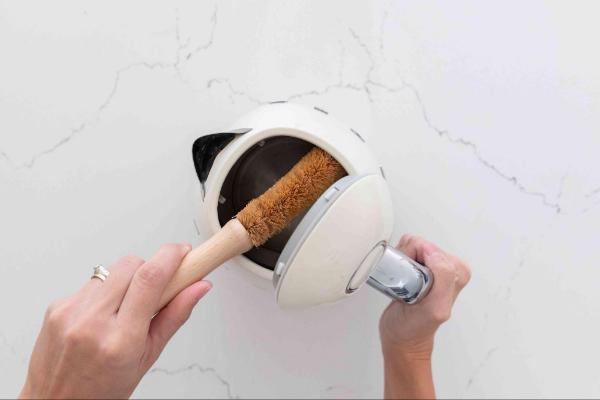Using an electric kettle to swiftly boil water for tea, coffee, or even quick meals like spaghetti or oatmeal can simplify kitchen tasks. The nicest feature is how little maintenance electric kettles require. Only every two to three months, or anytime you see buildup, do they need to be cleaned.
Electric kettles may accumulate minerals from the water or develop mold over time. Hard water, which is high in minerals, will cause buildup more frequently. Also, if something is left on your counter for an extended period of time, it may become dirty and clogged. To maintain clean surfaces and fresh water, follow these instructions for cleaning your kettle.
Recognizing The Value Of Maintaining Electric Kettle Filters:

It’s critical to comprehend the significance of cleaning electric kettle filters before beginning the cleaning procedure:
Prevents Mineral Buildup:
When water is heated to a high temperature using an electric kettle, dissolved minerals precipitate and deposit scale on the filter. This accumulation may hinder the flow of water, lower the kettle’s effectiveness, and decrease its life.
Guarantees Water Quality:
Mineral deposits and limescale can change the flavor and quality of boiling water, rendering it tasteless and possibly dangerous. Regular filter cleaning guarantees that the water you drink is clean and clear of impurities.
Increases Kettle Lifespan:
By reducing corrosion and mineral buildup, regular cleaning and maintenance of the electric kettle filter can increase the appliance’s longevity.
How To Clean Electric Kettle:

Materials That Will Help:
- White vinegar
- Soft brush or sponge
- Microfiber cloth
- Dish soap
Steps You Need To Follow:
Take Off The Cartridge Or Filter:
While not all kettles have one, the filters on those that do are typically found close to the spout. Pour equal amounts of warm water and vinegar into the filter or cartridge and leave it to soak. This will aid in clearing any accumulated debris. Although they may typically be cleaned, filters that are ripped or distorted may need to be replaced.
Put Water In The Kettle:
Pour in the same amounts of vinegar and water to halfway fill the kettle.
Bring The Water To A Boil:
After bringing the water to a boil, disconnect the kettle.
Give The Solution Some Time To Settle:
Give the vinegar and hot water mixture a full 20 minutes to sit. The heat and steam from the kettle will loosen any internal mold growth during that period. Pour away the vinegar and water mixture after 20 minutes.
Clean The Inside:
Scrub the sidewalls with a gentle sponge or toothbrush to get rid of any mold or mineral buildup. Dip the sponge or brush into vinegar if you need extra cleaning strength.
Clean The Kettle:
After adding fresh water and bringing it back to a boil, empty the kettle. As needed, repeat.
Replace The Filter:
Replace the filter once the kettle has cooled down.
Clean The Exterior:
Use a moist cloth dipped in soapy water to wipe the kettle’s exterior. Next, give it a dry wipe.
Clean The Foundation:
All you have to do is use a little moist towel to wipe down the base and heating element. Your kettle is then ready to use. Use a tiny bit of baking soda if you need more scrubbing strength. Steer clear of any industrial cleansers that contain harsh chemicals.
How To Maintain The Cleanliness Of Your Kettle:
While having a full kettle ready for when you want a cup of tea is pleasant, it is advised against storing water in your kettle to keep it clean and fresh over time.
Leaving water in the kettle in between uses can exacerbate problems with mineral accumulation and mold growth. Use the kettle instead, and then discard any leftover water. You don’t need to wipe the kettle entirely dry because it’s made to withstand some dampness.
Scrubbing the heating element could damage its ability to heat, so always avoid doing so. Dust can be removed from this area of the kettle without causing any harm by using a cloth that is only slightly moist. Wipe your kettle once a week as part of your counter-cleaning routine to keep it’s outside looking brand new.
The Insider Cleaning:
An electric kettle is easy to clean and maintain. Nevertheless, it’s crucial to do it frequently to maintain the wonderful taste of your boiling water and a clean kitchen. Every week, wipe off the outside, and every two to three months, clean the inside.
Once you bring equal parts water and vinegar to a boil, the heat from the kettle does the majority of the cleaning. Just wipe off the exterior and give the kettle a quick scrub to get rid of any rough spots. You can then relax with your preferred mug of tea, hot chocolate, or coffee. Lastly, make sure the kettle never runs out of water. When there is no more water in the tank, certain electric kettles have a feature called “boil-dry protection,” which turns off the heating element automatically. It’s a good idea to never fill over the “max fill” line and to always check the water level before beginning.
Long-Term Cleaning Advice For Your Electric Kettle:
After using the kettle, always make sure to empty all of the water. (Use the leftover water to rinse the sink or water plants.) Instead of using tap water, use distilled water. If your water supply comes from a natural well or you have hard water, this is vital. Boiling anything other than water in an electric kettle is not advised. While the boiling points of other liquids vary, a kettle is made exclusively for water.
FAQs:
What Is The Ideal Cleaning Solution For An Electric Kettle?
The best is vinegar, by dissolving the mineral accumulation, the acid in weak white vinegar will descale the kettle’s interior.
Is It Okay To Use Water To Clean An Electric Kettle?
You risk damaging the heating element of your electric tea kettle if you submerge it in a sink of water. As mentioned above, you can use water and vinegar or lemon juice to clean the inside of the kettle.
Is It Okay To Leave Water In A Kettle Unattended?
In a kettle, never leave water sitting acquire the skill of heating water only to the amount you anticipate using it each time.
How Is The Filter On An Electric Kettle Cleaned?
If the water filter in your electric kettle has a built-in filter, remember to clean the filter itself of any dirt. As directed by the manufacturer, remove the filter and give it a hot water rinse. After using a soft cloth to gently wipe the filter, let it dry and replace it.
Can Vinegar Be Used To Clean A Tea Kettle?
The best is vinegar. By dissolving the mineral accumulation, the acid in weak white vinegar will descale the kettle’s interior. You risk damaging the heating element of your electric tea kettle if you submerge it in a sink of water.
Conclusion:
Electric kettles are practical and simple to operate, but like any small item, they need to be cleaned sometimes to maintain their best performance. You must clean your kettle’s interior of any bacteria, mildew, or mineral buildup (known as kettle furring) if you want it to stay spotless.
Take off the cartridge or filter. While not all kettles have one, the filters on those that do are typically found close to the spout. Pour equal amounts of warm water and vinegar into the filter or cartridge and leave it to soak. This will aid in clearing any accumulated debris. Although they may typically be cleaned, filters that are ripped or distorted may need to be replaced.

